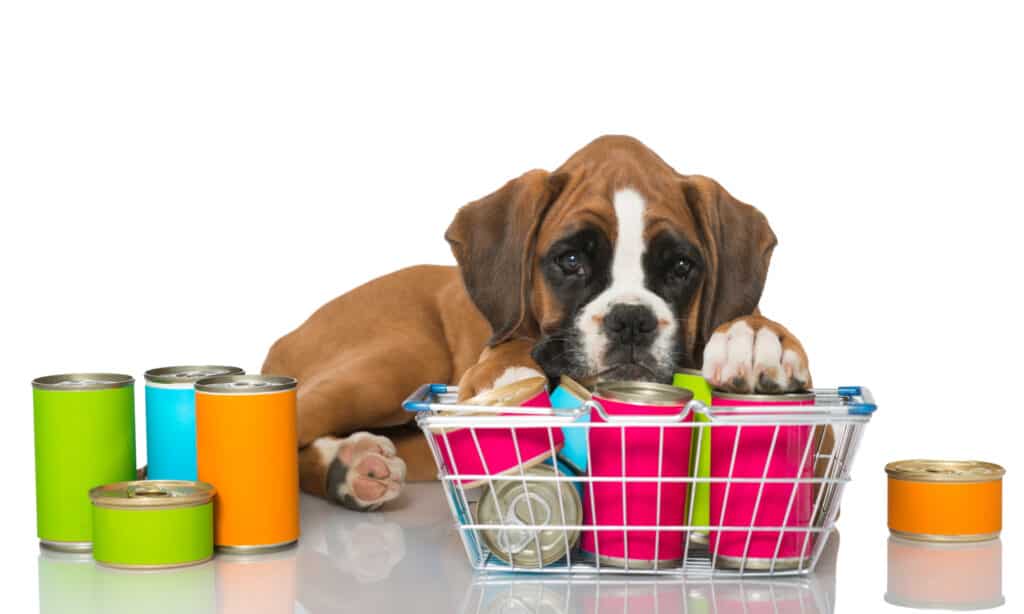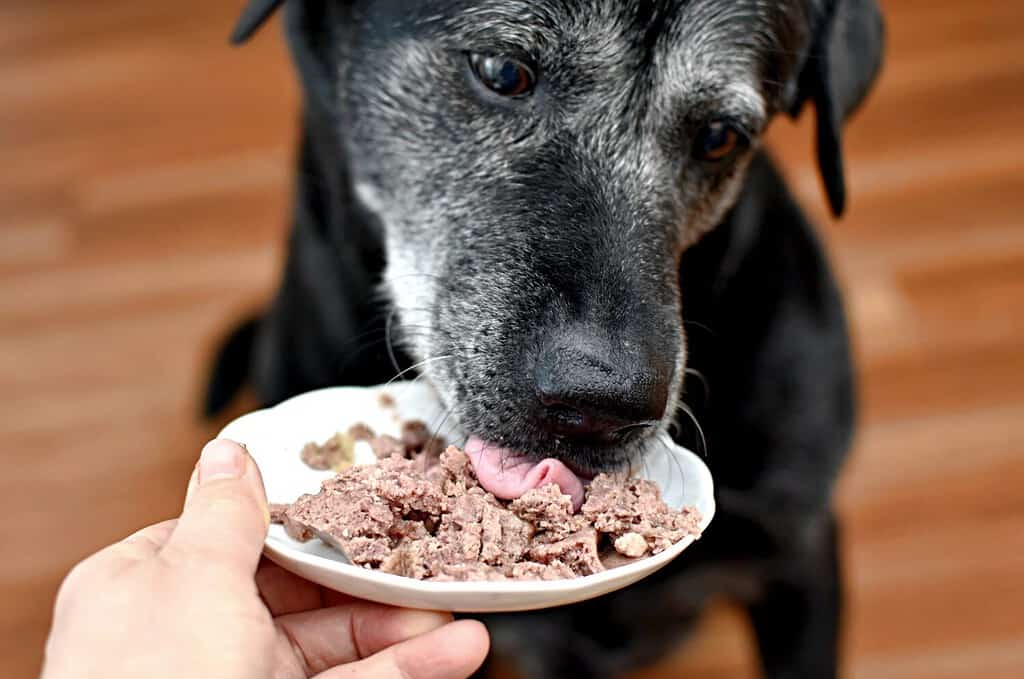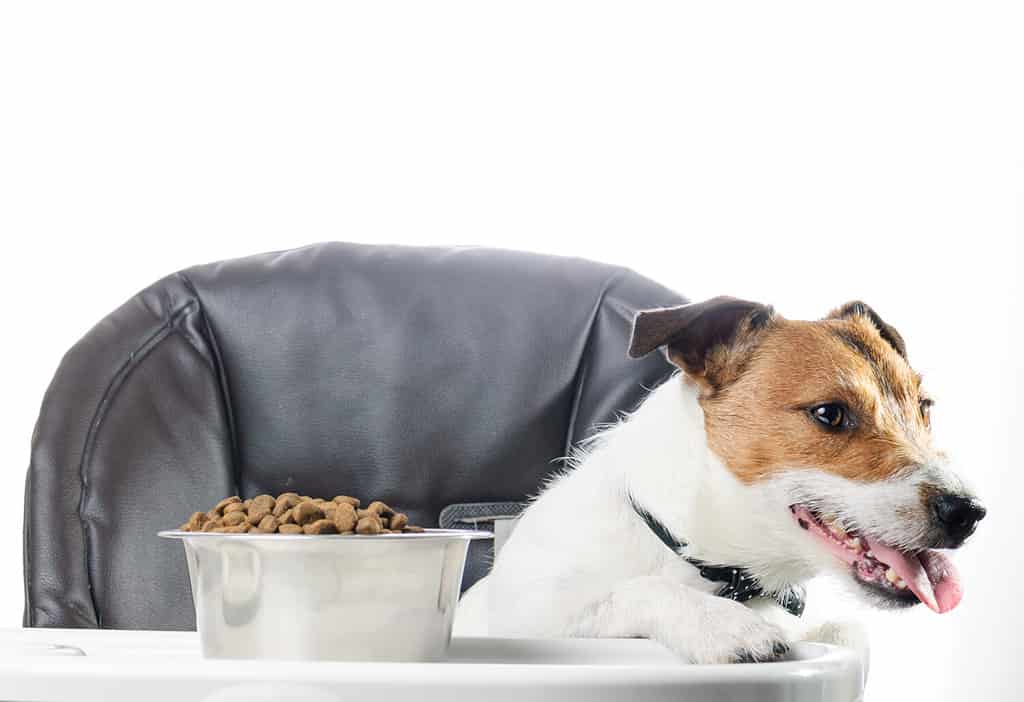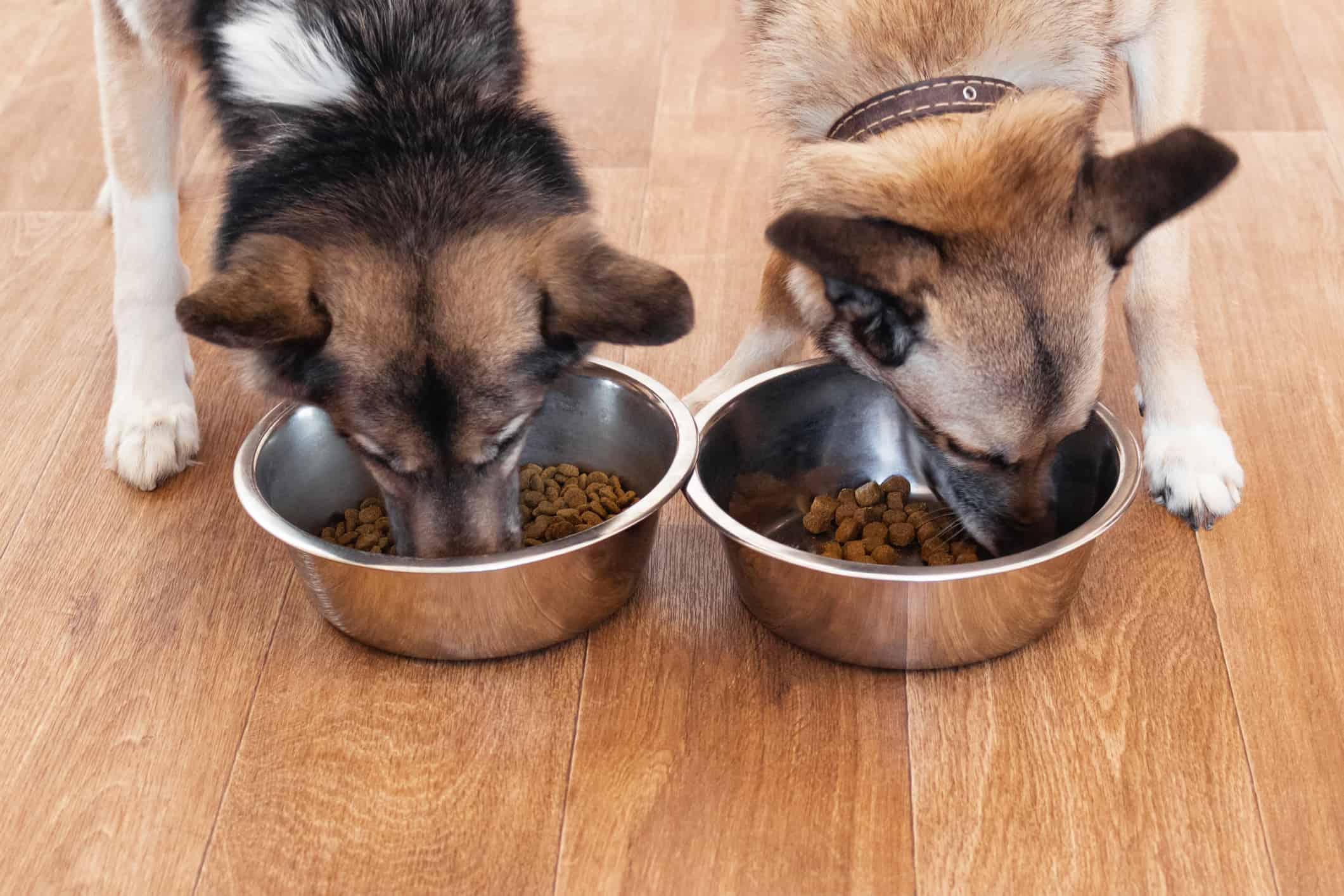What you feed your furry friend is a core factor of their health and longevity. However, there are many conflicting sources online on whether kibble, raw, or canned food is better for dogs. How do you choose which one is right for your pet? First, let’s take a look at what dogs have eaten historically to give us a peek into their natural diets.
What Do Dogs Eat?

Dogs can eat a variety of meat, grains, fruits, and vegetables.
©fotyma/iStock via Getty Images
While raw dog food companies are popping up left and right, most people still feed their dogs dry kibble or canned wet food. That’s because all of the nutrients our pups need are contained in those pieces of kibble or cans. Plus, commercial dog foods are highly regulated by the FDA and undergo rigorous testing by veterinary specialists.
Dogs are omnivore scavengers. While they eat mostly meat, they also get essential vitamins, minerals, and fiber from the grains, fruits, and vegetables in commercial dog food.
It’s important to remember that what dogs eat depends on their stage of life, current nutritional needs, and size. You need to feed a puppy differently than a senior dog. You also need to adjust the daily feeding requirements depending on whether you own a small or a large breed.
Canned or Dry Dog Food: What’s the Better Choice?

If you have a picky eater, canned dog food is a great option!
©Dora Zett/Shutterstock.com
It’s hard to compare canned and dry dog food when the better choice comes down to multiple factors like the dog’s age, lifestyle, size, and dietary needs. Let’s discuss what scenarios you might opt for canned food over kibble.
Canned food is often better for dogs who:
- Have a hard time eating because of dental issues
- Need an additional source of hydration
- Require fewer carbs but the same levels of protein and fat
- Are picky eaters or need new flavors to entice them
- Require medications or supplements since it’s easy to hide in the wet food
- Need to gain weight
When it comes to dry dog kibble, you might find that it is better for dogs who:
- Don’t eat all their food at once since it has a long shelf life
- Require a large amount of food because it’s cheaper than canned wet food
- Need to lose weight as dry food isn’t too enticing
- Tend to develop plaque on their teeth since chewing kibble helps reduce it
- Need slow feeders to eat
Now that we’ve gone over canned versus dry dog food, let’s compare a raw diet to feeding your dog kibble.
Is Raw or Kibble Better For Dogs?

A raw diet for their dog is becoming popular among many owners.
©iStock.com/Zontica
One of the main reasons dog owners choose to feed their pets a raw diet over kibble is because of the ingredients. They believe that grains and other fillers in dry food are negatively affecting their dog’s health. However, there are nutrients in grain and animal byproducts present in kibble that dogs need! Let’s bust some other common myths about dry dog food and learn more about why you might choose to feed raw instead.
Is Kibble Bad For Dogs?
Generally, dry kibble is not bad for dogs. It is even known to have positive effects on a dog’s dental and physical health! It all depends on the brand and the specific nutritional needs of your specific pet.
However, there are some general downsides to choosing to feed your dog dry food:
- Harder for some dogs to digest
- Less appetizing than other options
- Can’t rotate flavors because of the large bag sizes
- More carbs than canned or raw food
This doesn’t mean kibble is bad. It just means that you might encounter some extra challenges when feeding your dog dry food. But if cost and convenience are major factors for you, kibble is your best option since it is relatively inexpensive with a long shelf-life.
Raw Food Diet For Dogs
Now let’s talk about why you might opt to feed raw. If your vet recommends a high-protein, low-carb diet, then raw food is a better choice for your dog. A raw diet might also be good for dogs who develop allergies or digestive problems from dry food.
However, the cost of raw food is substantially higher than kibble or even canned wet food. It also requires refrigeration and for your dog to eat it when it’s served so it doesn’t spoil. Depending on your situation, this is either manageable or incredibly inconvenient. Your lifestyle will affect your decision, so consider that when choosing the best food for your dog.
Canned Versus Kibble Versus Raw: 8 Things To Consider

Age and activity level are two key factors to consider when choosing your dog’s food.
©Pommer Irina/Shutterstock.com
We’ve already discussed a few of the considerations when choosing food for your dog, but there are eight factors to consider overall.
1. Health
If your dog isn’t currently as healthy as they could be, it might be time to switch their food! A balanced diet is crucial for longevity. If you notice health issues that could be caused by the kibble your dog is eating, consult your vet about adding canned or raw food to their diet (or vice versa).
Just be aware that raw meats can contain harmful bacteria like salmonella and listeria that can hurt your furry friend. Canned and dry food doesn’t have this.
2. Level of Activity
A working dog needs more food than a lap dog. A raw diet might be the most cost-effective way to feed a Belgian Malinois while kibble or canned food works fine for a beagle or Yorkshire terrier.
3. Age
Age has a major effect on the type of food you feed your pet. A senior dog will most likely need raw or canned food if they have any dental issues due to their age. Kibble is fine for dogs as they get older, but they tend to not be able to chew it well.
4. Size
Nutritional requirements vary between dog breeds depending on their size. A small dog isn’t going to need as much food as a large dog, which is a factor in choosing the right food for them.
5. Allergies
If your dog is allergic to ingredients common in dry and canned food like corn, eggs, or wheat then a raw diet might be beneficial. That’s because you have control over the individual ingredients when you feed raw.
6. Taste
If your dog is a picky eater, finding the right food for them can be a challenge. Often, canned wet food is more enticing than dry kibble. If you can’t afford to solely feed your dog wet or raw food, consider topping the dry food with it instead to entice your pup to eat.
7. Your Lifestyle
While many owners believe a raw diet is better for their dogs, many vets will tell you that commercial-grade kibble has everything your dog needs to be healthy. So sometimes, the decision comes down to your lifestyle.
Are you home when your dog eats or do you need to set it out and leave it? Do you have a refrigerator to store canned or raw food for your dog? Your lifestyle is just as important of a consideration as your dog’s!
8. The Cost
The last, and sometimes the most critical, factor when it comes to what to feed your dog is cost. Even if you want to feed your dog a raw diet, not everyone can afford to do so. If price is your highest consideration, kibble is the way to go.
Chart For Deciding What Food to Feed Your Dog
| Canned | Kibble | Raw |
|---|---|---|
| If they have a hard time eating because of dental issues | If they don’t eat all their food at once | If they have allergic or digestive symptoms from canned or dry food |
| If they need an additional source of hydration | If they require a large amount of food | If they need an additional source of hydration |
| If they require fewer carbs but the same levels of protein and fat | If they can maintain their weight while eating more carbs | If your vet recommends a high-protein, low-carb diet |
| If they’re picky eaters | If they tend to develop plaque on their teeth | If they’re picky eaters |
| If they require medications or supplements | If they need slow feeders to eat | If they require medications or supplements |
| If they need to gain weight | If they need to lose weight | If they need to gain weight |
What’s The Best Choice: Dry Dog Food, Raw Diet, or Canned Food?

Ultimately, the best choice for what to feed your dog is up to you!
©alexei_tm/Shutterstock.com
Did you notice a theme throughout this blog? There is no single answer for whether kibble, raw, or canned food is better for dogs.
You might feed your senior dog canned food since they can’t chew very well, but your new puppy gets dry food and raw to promote healthy development. When your puppy grows up, you might find that a raw diet gives them diarrhea and switch to only kibble. The answer to what’s the best choice for dog food is… there is no best choice.
That’s because each dog requires unique dietary considerations for optimal health at every stage of their life. So consult with your vet, do your due diligence to find out what your dog’s nutritional needs are, opt for a trusted brand, and feel confident you’re choosing the best food — whether canned, dry, or raw — for your dog!
Ready to discover the top 10 cutest dog breeds in the entire world?
How about the fastest dogs, the largest dogs and those that are -- quite frankly -- just the kindest dogs on the planet? Each day, AZ Animals sends out lists just like this to our thousands of email subscribers. And the best part? It's FREE. Join today by entering your email below.
Thank you for reading! Have some feedback for us? Contact the AZ Animals editorial team.








